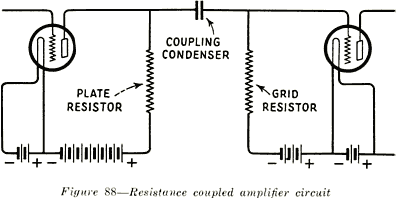This pulsating current as stated above is made of two components, one component being an
alternating current.
The alternating component of the plate current induces a voltage in the secondary of the transformer
due to transformer action. The voltage of the secondary is then impressed on the grid of the next tube.
Although transformer coupling, as in the case of impedance coupling, does not inherently permit equal
amplification of all frequencies, practically, it accomplishes this within the limits required for natural
reproduction of sound.

The advantage of transformer coupling is that it permits an increase of voltage between the vacuum
tubes, because, as stated in section 19, a transformer can be
wound to give a higher voltage on the secondary than that which is impressed on the primary.
Therefore the amplification per stage can be greater than the amplification of the tube. Coupling
transformers used in voltage amplifiers usually "step-up" the voltage three to four times.
129. Classification of Amplifier Circuits.-It is customary to think of the steps of amplification as
"stages." Thus a stage of amplification consists of one or more vacuum tubes and associated circuits
used in amplifying a voltage from one value to another. The beginning of one stage is usually
considered to be the grid of one tube, and the end of the stage is at the grid of the next tube in the line
of increasing voltage. Stages of amplification are classified according to type of circuit, such as "a
stage of resistance coupling," "a stage of transformer coupling," etc., and according to the position of
the stage in the amplifier such as "the input stage," "intermediate stage," and "output stage"; or in the
classification of amplifier units according to another classification of circuits, such as "push-pull"
stage, "stage of parallel operation," etc. The word "cascade" is used to describe the arrangement of
stages in which each stage successively increases the voltage being amplified.
6
